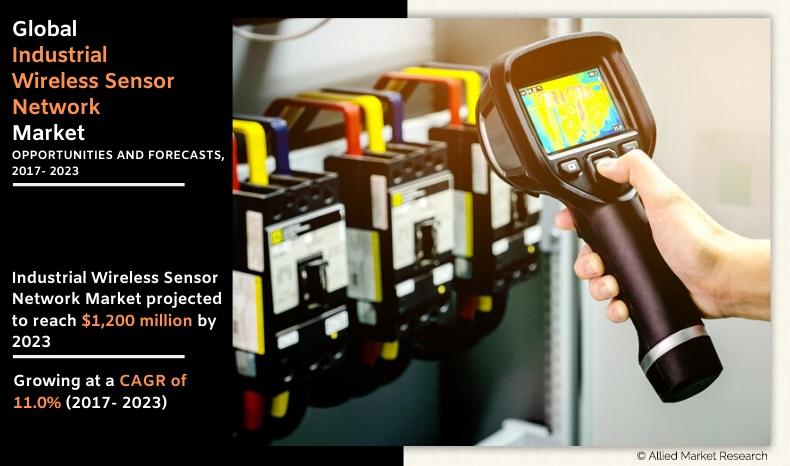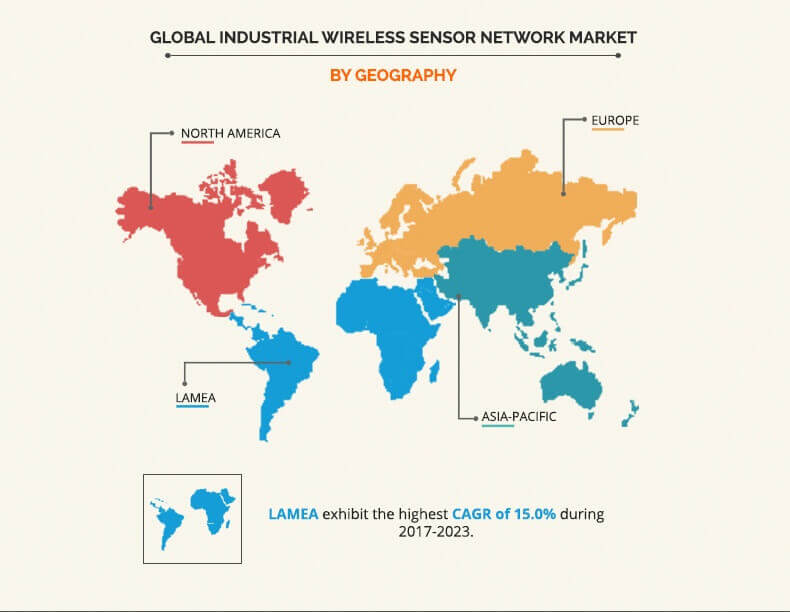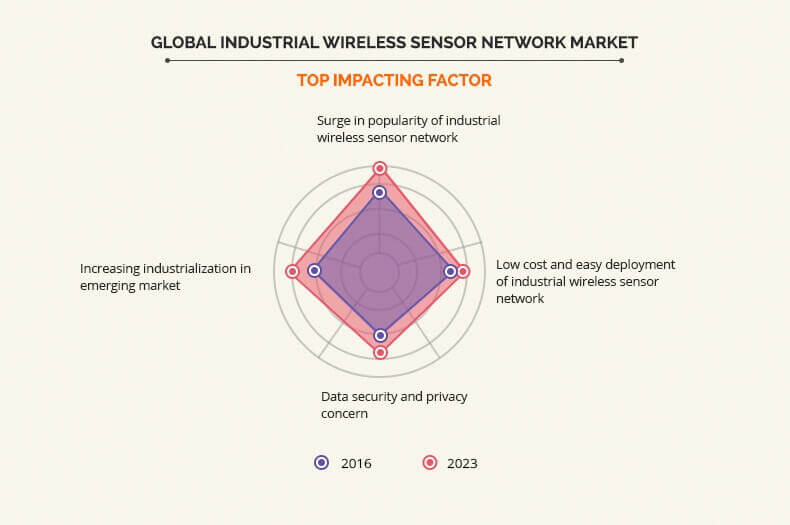Industrial Wireless Sensor Network Market Overview:
The Global Industrial Wireless Sensor Network Market was valued at $573 million in 2016 and is projected to reach at $1,200 million by 2023, growing at a CAGR of 11.0% from 2017 to 2023.
The industrial wireless sensor network (IWSN) is a network of distributed sensing platforms with wireless communication. IWSN is positioned in remote areas and uses wireless technology to transmit signals to the control room. Furthermore, the system can be controlled, troubleshot, and monitored remotely. Moreover, it is majorly used for process & control monitoring and data processing.
The global industrial wireless sensor network market is expected to register substantial growth shortly, owing to the surge in popularity of IWSN among various industry verticals such as oil & gas, automotive, manufacturing, healthcare, and others. Furthermore, the increase in the need to improve process efficiencies and easy deployment of industrial wireless sensor networks drive the market growth. Advantages offered by IWSN such as its easy-to-use & application-specific nature further fuel its adoption. However, the rise in data security and privacy concerns is the key factor that hinders the growth of the market.
ABB Ltd., STMicroelectronics, Honeywell International Inc., Texas Instruments, Inc., Siemens AG, Endress+Hauser AG, Linear Technology Corporation, NXP Semiconductors, Schneider Electric, and Emersion Electric are some of the key players operating in the global industrial wireless sensor network market.
The industrial wireless sensor network market is segmented based on sensor, technology, application, and geography. Based on sensors, the market is categorized into pressure sensors, temperature sensors, level sensors, flow sensors, biosensors, and others. Based on technology, it is classified into Zigbee, Bluetooth, Wi-Fi, and others. By industry vertical, it is fragmented into oil & gas, automotive, manufacturing, healthcare, and others. Geographical breakdown and deep analysis of each of the aforesaid segments is included for North America, Europe, Asia-Pacific, and LAMEA.
Factors that are expected to impact the global industrial wireless sensor network market during the forecast period are as follows:
- Surge in popularity of industrial wireless sensor network
- Low cost and easy deployment of industrial wireless sensor network
- Data security and privacy concerns
- Increase in industrialization in the emerging markets
Surge in Popularity of Industrial Wireless Sensor Network
Industrial wireless sensor technology has gained traction over recent years, as it enables enterprises to monitor and control various parameters such as temperature, vibration, pressure, and others remotely which reduces time and cost. Furthermore, the increase in the need to improve process efficiencies and meet corporate financial objectives is fueling the demand for low-cost industrial automation systems such as industrial wireless sensor networks. In addition, these systems provide multiple benefits over traditional wired industrial monitoring and control systems such as rapid development, flexibility, self-organization, and intelligent processing capability. Moreover, the significant role played by them in creating a reliable and self-healing system that responds to real-time events with appropriate actions is fueling the growth of the market.
Data Security and Privacy Concerns
Industrial wireless sensor networks have transformed the controlling and monitoring process, as they control, troubleshoot, and monitor various parameters such as temperature, vibration, pressure, and others remotely. This reduces cost, time, and the hassle of installing & maintaining a wired sensor network. Furthermore, the benefits offered by IWSN such as easy deployment, flexibility, self-organization, and intelligent processing capability are attracting organizations towards it. However, an increase in data security concerns related to data access from Bluetooth networks, Zigbee, IoT other wireless networks is expected to hinder the market growth.
Key Benefits for Stakeholders
- This study comprises an analytical depiction of the global industrial wireless sensor network market with current trends and future estimations to portray the imminent investment pockets.
- The overall market potential is determined by understanding the profitable trends to gain a stronger foothold.
- The report presents information related to key drivers, restraints, and opportunities with a detailed impact analysis.
- The current market is quantitatively analyzed from 2017 to 2023 to highlight the financial competency of the market.
- Porter’s Five Forces analysis illustrates the potency of the buyers and suppliers in the industry.
Industrial Wireless Sensor Network Market Report Highlights
| Aspects | Details |
| By Sensor |
|
| By Technology |
|
| By Industry Vertical |
|
| By Region |
|
| Key Market Players | Texas Instruments Inc., ST Microelectronics, ABB, Ltd, Endress+Hauser Management AG, NXP Semiconductors N.V, Schneider Electric, Siemens AG, Emersion Electric co., Linear Technology Corporation, Honeywell International Inc. |
Analyst Review
The industrial wireless sensor network (IWSN) is the network of distributed sensing platform with wireless communication. IWSN is positioned in remote areas that uses wireless technology to measure or transmit signals to a control room. Furthermore, the system can be controlled, troubleshot, and monitored remotely. IWSN is majorly used for process & control monitoring and data processing. Moreover, advantages offered by IWSN such as easy deployment, flexibility, self-organization, and intelligent processing capability are fueling the market growth.
By industrial vertical, oil & gas segment is dominant segment in 2016. Based on sensor type, level sensor is expected to register the highest CAGR of 14.6% during the forecast period, followed by biosensor and temperature sensor with CAGR 13.8% and 11.9%, respectively.
ABB Ltd., STMicroelectronics, Honeywell International Inc., Texas Instruments, Inc., Siemens AG, Endress+Hauser AG, Linear Technology Corporation, NXP Semiconductors, Schneider Electric, and Emersion Electric are key market players operating in the industrial wireless sensor network market.
Loading Table Of Content...






